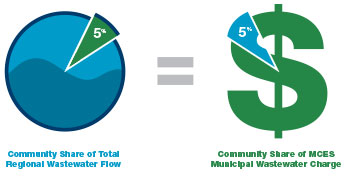Funding and Finance
Metropolitan Council Environmental Services rate policies
User fees cover all expenses
Metropolitan Council Environmental Services operates the regional wastewater collection and treatment system (also called the Metropolitan Disposal System) for the seven-county metro area. Every home, business and industry that does not use an individual septic system is connected to the regional system.
User fees cover the entire cost of wastewater operations as well as the cost to maintain, replace and upgrade the physical infrastructure of the system.
More about how the Council sets its rates and fees.
Treatment system supports region’s livability, prosperity
The Metropolitan Disposal System serves about 2.9 million people. The system consists of:
- More than 640 miles of interceptor pipes, up to 14 feet in diameter, that collect wastewater from more than 5,000 miles of sewer pipes owned by cities and townships.
- 61 lift stations that pump flow to treatment plants where gravity isn't sufficient because of land elevation changes.
- 226 metering stations that help determine each community’s share of regional costs.
- 10 relief sites.
- 9 water resource recovery facilities.
Three major sources of revenue
Metropolitan Council Environmental Services revenue comes from three types of user fees:
 Municipal wastewater charges
Municipal wastewater charges
In 2024, Metropolitan Council Environmental Services collected close to $282 million in municipal wastewater charges from the 111 communities served by the regional system. Met Council municipal charges are very competitive. Nationally, our rates are well below average for similar-sized agencies, according to the National Association of Clean Water Agencies.
Each community pays an allocated portion of the total municipal wastewater charge based on the volume of wastewater Met Council treats from the community in the previous calendar year. Most communities cover their local sewer costs by charging a higher “retail” rate to residents and businesses. Learn more about municipal wastewater charges.
Industrial charges
Metropolitan Council Environmental Services charges industrial customers to cover the cost of wastewater monitoring, treating higher strength discharges, and other costs. The charges are made in a variety of forms:
-
Annual permit fees
-
Strength charges for wastewater that has higher treatment costs than typical residential wastewater
-
Fees to liquid waste haulers who dispose of septage, leachate, and other hauled wastes directly into the regional wastewater system
-
Other fees
In total, Metropolitan Council Environmental Services collected about $21.3 million from industrial charges in 2023.
Sewer Availability Charge (SAC)
When we extend new sewer pipes into growing areas, or rehabilitate or replace aging pipes in older communities, we build enough capacity in those pipes to handle future growth. This is called reserve capacity.
SAC is a one-time fee we bill local governments for use of the reserve capacity in the Metropolitan Disposal System. We charge SAC whenever a new property is built, or an existing property renovation causes increased capacity demand. SAC pays for the reserve capacity through capital or debt service payments associated only with the reserve capacity portion of the system.
Local governments may also charge, on top of the Metropolitan Council Environmental Services SAC fee, a local SAC or add-on fee for capacity in the local sewer system.
One SAC is based on 274 gallons per day of potential capacity. It is not based on actual or expected usage. Low usage benefits are realized through low monthly treatment bills. Instead, SAC is based on the capacity needed for wastewater to flow effectively under maximum potential usage.
In 2023, Metropolitan Council Environmental Services used $60.1 million from SAC revenues to support capital expenses and debt service associated with providing needed reserve capacity in the regional wastewater system. Learn more about SAC.
Rates reflect cost of service
Metropolitan Council Environmental Services sets municipal wastewater and industrial rates based on what it costs us to provide the service. Our rate system is equitable across the region and supports economic development.
Communities pay for the wastewater flow originating within their borders. New users pay for the capacity they demand through a sewer availability charge (SAC). Industries pay for the cost of treating their higher-strength discharges through a strength charge. Haulers pay for wastewater loads based on the cost of receiving and treating the loads.
When we propose changes to SAC or other fees we engage our customer communities in the process. We hold stakeholder meetings as well as a public hearing, and give notice of at least three months before we implement changes. We sometimes establish a community task force or work group to explore issues and make recommendation(s) to the Met Council.
The Met Council has final approval of all recommendations.
Additional resources